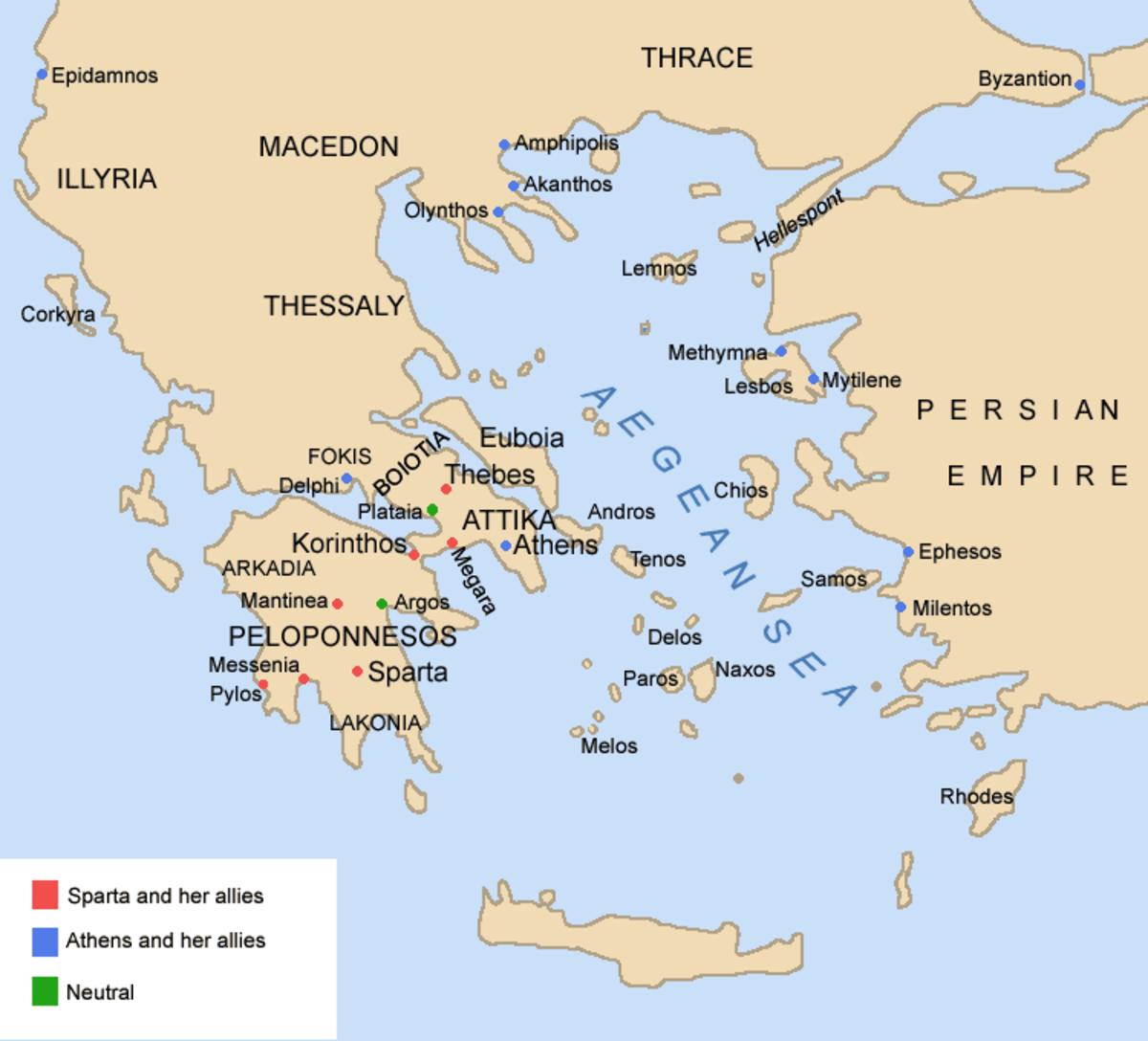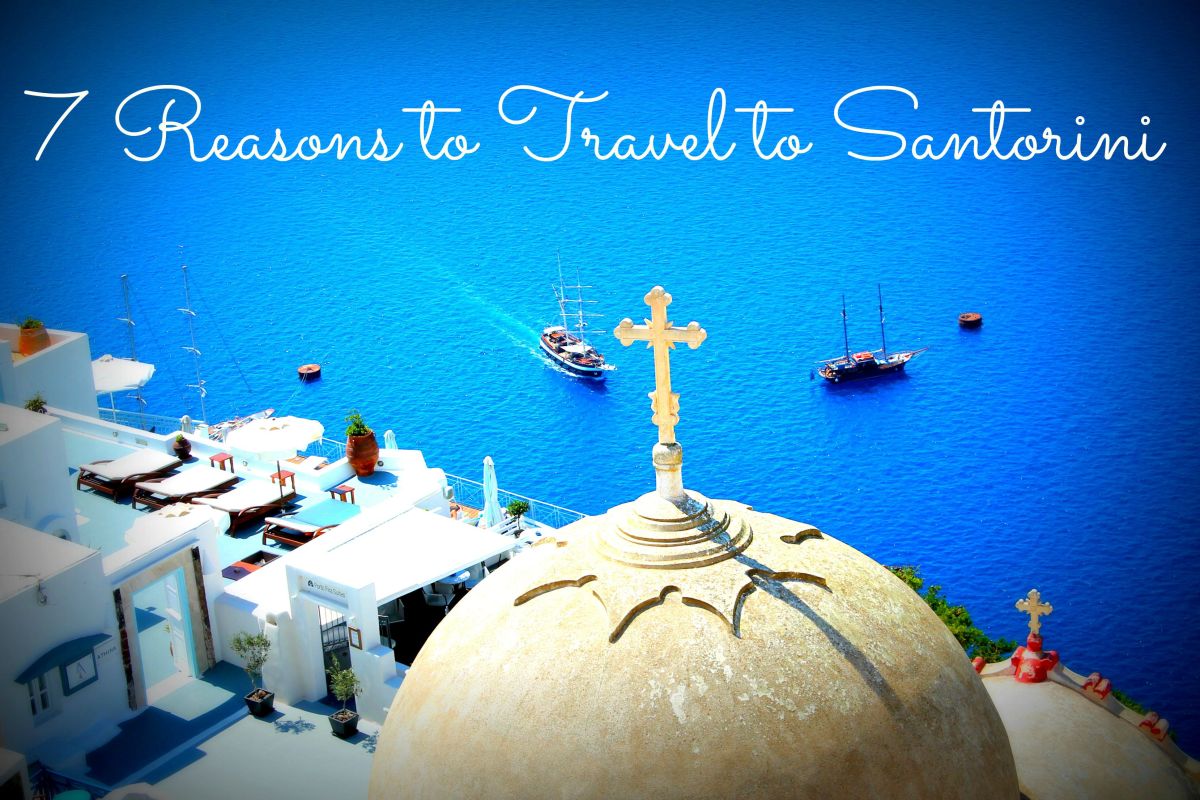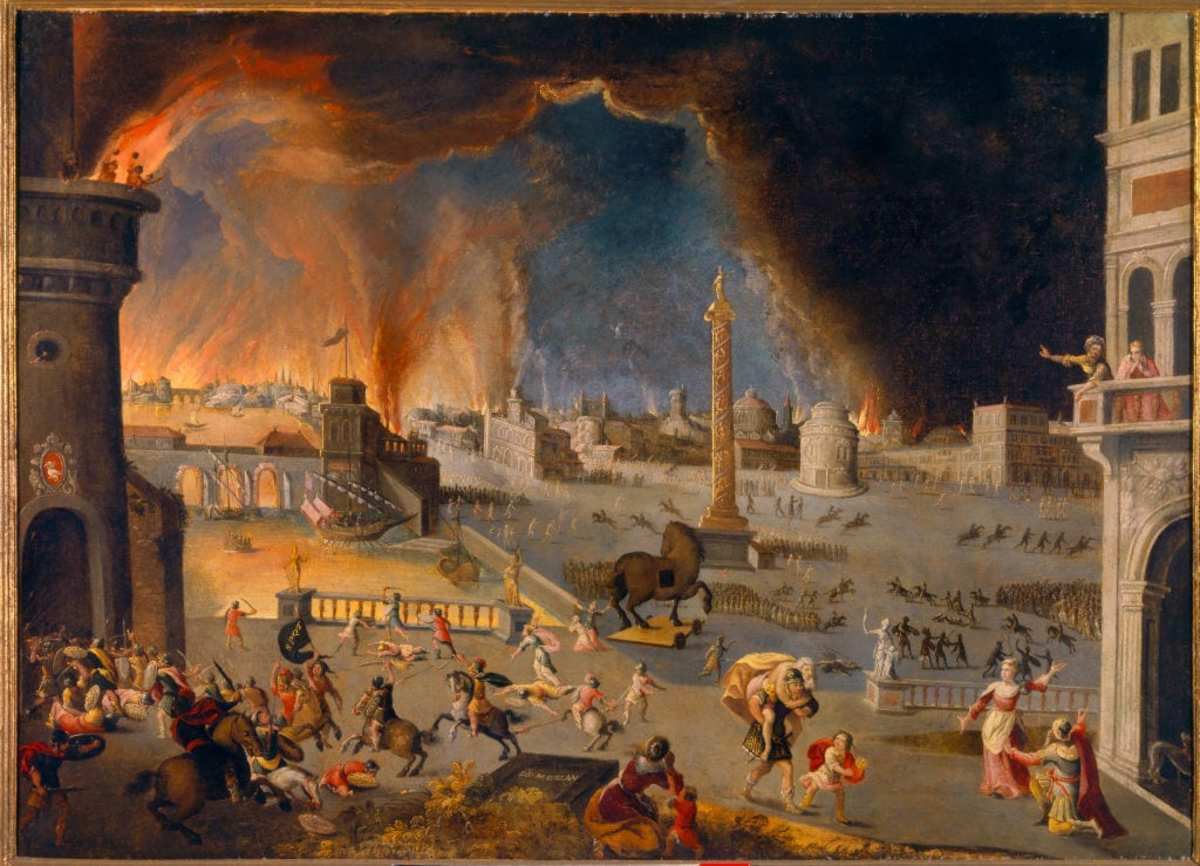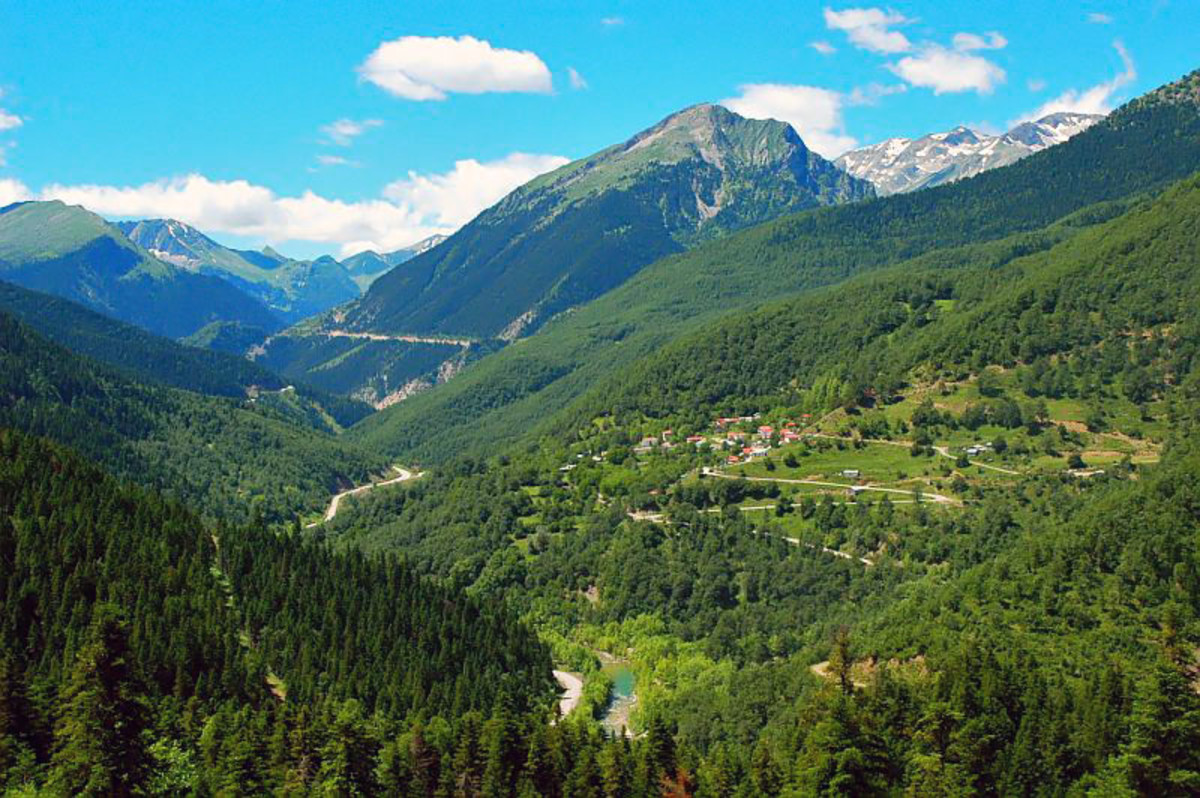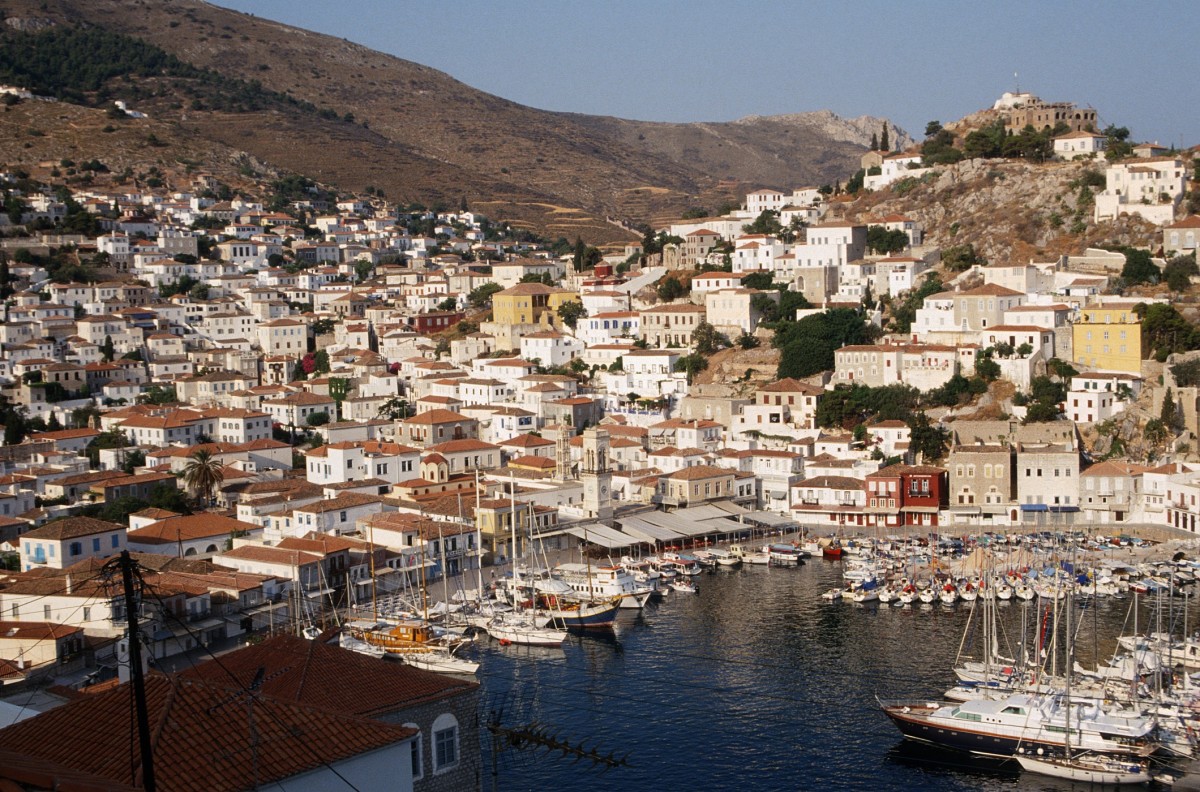Athens - a History and its Golden Age
Athens (Ahinai) is the capital city of Greece with a metropolitan area that has a population of about 4 million. It's population is about 890,000 people. The larger urban zone of Athens is the 7th largest in the European Union. The city is one of the oldest cities int he world with a continuous inhabitation of more than 4500 years recorded history of about 3400 years. The ancient Athens was the cultural center of the ancient Greek world. Many of the writers who lived there influenced the literature up to the present time. The ancient Athenian stateman Pericles called Athens the "School of Greece". Athens is considered as the “Cradle of Western Civilisation”. Democracy was first establish here.
Attica
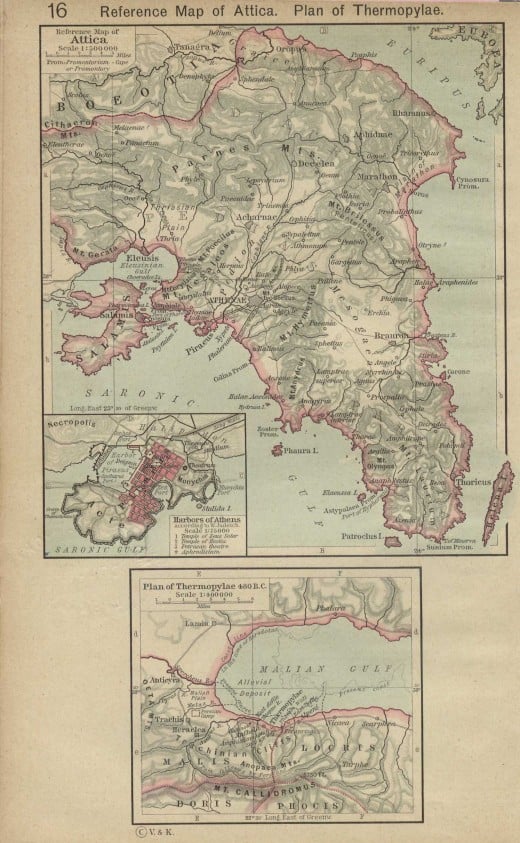
The city is named after the greek goddes, Athena. Athens lies on a plain near the end of Attica (a peninsula that extends from south-eastern Greece into the Aegean Sea). The city is about 5 miles (8 kilometers) from Piraeus, Greece's largest seaport. The Eridanus River flows through it. Its scientific, mathmatical, phylosophical, legal, and cultural inheritance affects our world to this very day.
Solon
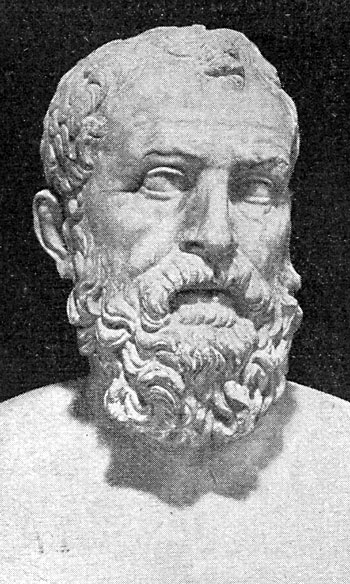
Although the area was inhabited since the later part of the stone age, Athens was founded sometime between the 3rd and 4th century. By about 1400 B.C. the early Athens was an important center of the Mycenaean civilisation. At around 1200 B.C. other centers of the civilisation were abandoned, due to invasions by the Dorians, however Athens was not. This invasion caused the decline of the city, becoming not much more than a fortress. The first major building of the area was the Acropolis, which means “high city”. Acropolis was built on a hilltop, and served as a fortress. The walled city had roughly 2 km east-west-, and north-south width. Acropolis was a little south of the center of the city. Atop Acropolis was the most important religious site for ancient athensians, the Parthenon, in which the greek goddes of Athena was worshiped. In 776 B.C. the first Olympic game was held, in Olympia (located northwest of Sparta and South west of Athens). The olimpic games were held every four years until the last game in 393 A.D. At around 500 B.C. the population of Athens is said to be 140,000. The number of slaves of the era is put somewhere between 150,000 and 400,000. In the 4th century the macedonian king, Alexander the Great conquered the city, causing many of the residents of the city to leave Athens and head to the east. Athens became a regional power in the 9th century B.C. with one of the most developed and richest among the Greek city states. Due to its central location and access to the see. Athens brought outher smaller towns and settlements in the Attica peninsula under it rule, But by the 7th century B.C. social unrests became more and more prevailent. Draco was appointed to deal with the issue and he made very strict laws and rules to restore order, however, failed in doing so. Solon was appointed as his successor. Solon limited the power of the ruling classes, by a series of political, and economic reforms, including the abolishment of slavery, freed trade and commerce. He also divided the people of Athens into four classes, based on their wealth and militaristic ability. Even the lowest, and poorest class received voting right for the first time in their history. This system was to basis of the later Athenian democracy. 20 years later, however, one of Solon’s cousin, Peisistratus seized power in 541 B.C. Peisistratus made Athens a dominant power in the wider region, both economically and militaristically (most notably its naval force). After he died following 14 years of rule, his sons suceeded him The rapidly changing rulers of Athens in the Era were overthrown with the help of the Spartan army. In 510. B.C. an aristocrat by the name of Cleisthenes stepped on the scene who enforced a number of reforms, establishing the democratic Athens.
Cleisthenes
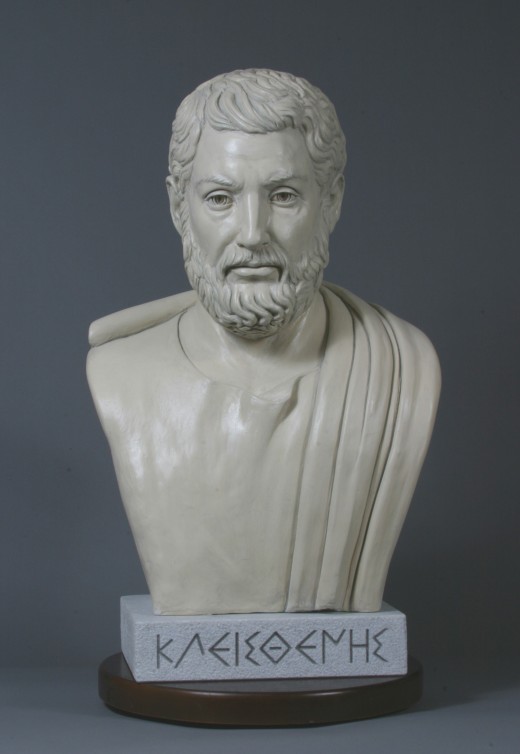
Cleisthenes replaced Solon’s 4 class system with 10, however these 10 classes were called electorates, and were not based on the traditional classification methods of Solon. These 10 electorate classes were also called tribes. The tribes were divided further to 3 trittys each- Trittys were also divided to one or more demes. The number of demes depended on the population of these demes. Demes can be considered the local governing bodies. Each tribe (electorates) each elected fifty members to the council (named Boule) governing Athens. The Assembly had two primary functions, it passed legistlatures, and also was a supreme court. As such it was open to all citizens of Athens. Murder-, and religious cases were the only cases not dealt with by the Assembly, they were remained the responsibilities of the Areopagus. Areopagus functioned as a religious court. This is one of the first examples in history for the separation of state and religion. Most offices were filled by lot, except for the 10 generals (strategoi) of Athens, which were elected. Strategoi had the duties of planning military expedititons, receiving envoys, of other Greek states, and directing the diplomatic affairs of Athens. This system established in 510. B.C. remained in place until the conquer of Athens in 338 B.C. by Alexander the Great.
Battle of Salamis
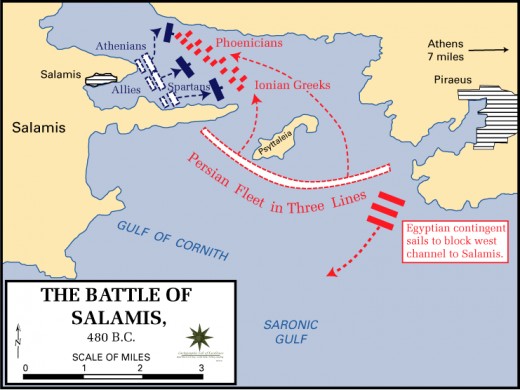
In 499 B.C. Athens sent troops to aid Ionian Greeks’ revolt against the Persian Empire, leading to Persia initiating two invasions against Athens. The first invasion led by King Darius (də-,rī-əs) of Persia was halted and stopped in 490. B.C. by Athenian military leader and statesman Miltiades (mil-,tī-ə-,dēz) in the battle of Marathon. During the following, and last Persian invasion led by Persian King Xerxes (pronounced: zərk-,sēz), resultin in the evacuation of the city of Athens in 480, before the arrival of the persians in the city, who finding it empty burned it down. At the naval Battle at Salamis in September of 480 B.C., Athenians and their allies led by athenian Themistocles achieved a decisive victory over the Persian Empire, enabling Athenians to return to Athens and to start rebuilding it. The Battle of Salamis also enabled Athens to take to role of supremacy in the region from the Spartans. Athens also led war campains to Asia Minor (pressent day Turkey) after this.
Pericles
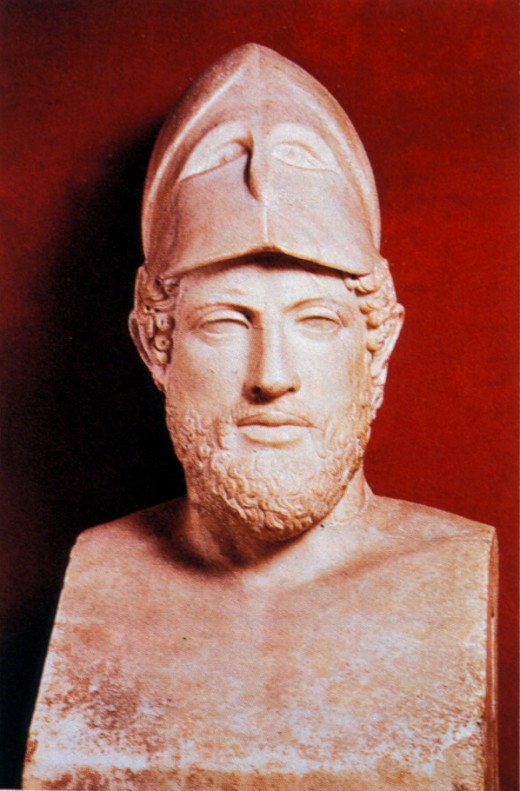
Golden Age of Athens (Pericles as leader)
Between 448 and 430 B.C. the Golden Age of Athens arived. This era is also denoted as the “Age of Pericles” after the polihistor man Pericles, who excelled in military leadership, politics, oratory, philosophy, architecture, sculture, history, music and literature. The end of the era is marked by the death of Pericles (pronounced: per-ə-,klēz). Pericles fostered arts and literature, executed large number of public construction works, and in general he made big steps in improving the everyday life of the citizens of Athens. Pericles was elected the strategos (chief strategoi) in 445 B.C. as the successor of Ephialtes, who was assasinated by his enemies. Among the many reforms of Pericles, the most popular was that he granted rights for the citizens of Athens without wealth (called thetes) to be able to occupy office. He also intoduce a special salary for the jurors of court, the significant of this was that citizens to occupied this job was now able to dedicated themselves to public service without the fear of financial difficulties. This obviously widened to opportunty for many more people to become jurors, not just the rich citizens of Athens. People in Athens were able to govern themselves, without the use of intermediaries, by having the right and opportunity to decide matters of the state directly in the Assembly. Now the poors’ oppinion was equal to that of the rich in the Assembly. Citizens of Athens had equality of speech in the Assembly. However, many poor did not have the ability to participate in the Assembly, due to extreme poverty and ignorance, leaving the danger of corruption and fraud. To prevent this from happening, the poorest were helped in the following ways:
- Concession of salaries to public functionaries,
- To seek and supply work to the poor,
- To grant lands to dispossessed villagers,
- Public assistance for invalids, orphans and indigents,
- And other social helps.
As a result of these steps the level of poverty in Athens was greatly reduced. Athenians lived a modest life, and there were very few exceptional fortunes. Great luxury was also not the norm among the rich.
Most importantly, and in order to emphasize the concept of equality and discourage corruption and patronage, practically all public offices that did not require a particular expertise were appointed by lot and not by election. Among those selected to a political body, each specific offices were rotated so that every single member served in all capacities.
Institutions of Pericles’ Athens
Magistrates
The magistrates were people who occupied a public post and formed the administration of the Athenian state. They were submitted to a stict public control. The magistrates were chosen by lot. There were only two categories of posts which were chosen by election in the Assembly, that of strategos of the magistrate of financeas both of those posts required very specific skills and qualities to manage properly. A magistrate's post did not last more than a year, including that of the strategoi, except for Preicles, who was selected year after year. At the end of every year, a magistrate would have to give an account of his (magistrates were predominantly men) administration and use of public finances. As the strategoi were the most important officers, since they commanded the army and the navy, 10 strategoi were elected each year by the Assembly. There were more then 100 other offices to hold.
Assembly
The Assembly was the first body of the democracy. Theoretically, the Assembly intended to bring together all the Athenian citizens, however only about 6,000 did so in practice. The Assembly gathered together in front of Acropolis. The assembly gathered about 40 times a year (Athens used a 12 month lunar calendar system, not the modern Gregorian calendar). The Assembly decided on the laws and the decrees. Bills were voted in two stages; first the Assembly came to a resolution and then the Council decided whether it approved.
Council (Boule)
Council members also met in front of the Acropolis (on Pnyx hill), in a place expressively prepared for the meeting. All the 500 Council members were chosen by lot. The members of the Council had four primary roles: study and examination of legal projects, the overseeing of the more then 100 magistrates and their activities, overseeing the proper functioning of the day-to-day administrative details, and the overseeing of the external affairs of the state.
Finances of Pericles’ Athens
All of the constuctions and buildins, and other expenses that created the greatness of ancient Athens would not have been possible without the financial contributions of the Delian League. The Delian Leage was an association of about 150 differrent Greek states under the leadership of Athens. The treasury of the League was located on the island of Delos, howver, Pericles moved it to Athens. Pericles’ excuse for this move was that Delos was not safe enough for a treasure of that size. This resulted in a number of states’ rebellion. Athens retaliated these rebels, indicated that Athens acted more like an empire, than a leader of a league.
Another source of revenue Pericles’ Athens had was from customs, and customs fines. During military campaigns the rich citizens of Athens were forced to pay a higher tax than at times of peace. Citizens also paid taxes on a regular basis. Warships of Athens (called tritemes) were also popular among rich Athenians in the form of sponsorship. Probably one of the reasons Triremes were sponsored so mauch is because sponsors became leders of them as long as thes sponsored them.
Culture During Pericles’Athens
Pericles’s Athens say the emergance of cultural, philosophical, and literatural life. Most notable writers of the time were Sophocles, Euripides, Aristophanes. Major philosophers were: Socrates (Aristotle and Plato where his students) and Protagoras. Most notable historian of Pericles’ time was Herodotus.
Athens after the Death of Pericles
Following the death of Pericles Athens entered into a long period of slow decline. This decline can be attributed to the fact that Athens was continuously preoccupied with a number of serious wars, demanding both great sums of money, and lives of the citizens of Athens.
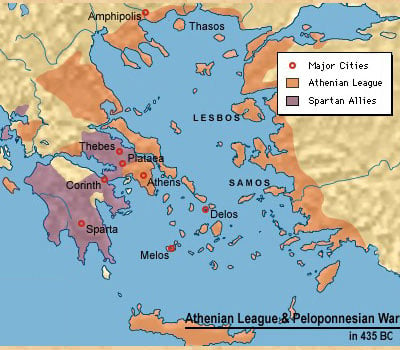
Peloponnesian War
In 431 B.C. Athens entered the Peloponnesian War. In the Peloponnesian War Athens fought against a reemerging Sparta, which had its own loose league of city states also, and this war was about a struggle for power and supremacy between the the Delian League, or rather the remainders of it, against the Peloponnesian League (led by Sparta). The Peloponnesian War lasted between 431 and 404 B.C., so for a little less then 30 years. The war started by Sparta launching repeated invasions of Attica (the peninsula where Athens is located). Meanwhile Athens, using its naval supremacy raided the coast of Peloponnese, the peninsula west from Athens in which Sparta is built (along with other smaller city states). The Pelopnnesian War ended with the defeat of Athens and the signing of the Peace of Nicias in 421 B.C. The Peloponnesian is considered as the end of Athneian naval supremacy (the only real supremacy of Athens militaristically speaking). By 404 B.C. Athens was completely defeated, and the Peloponnesian War ended. As Athenians blamed the democratic leaders for the defeat, and, by the aid of the Spartan Army, democracy ended, however, next year, in 403 B.C. democray was restored, and amnested declared.
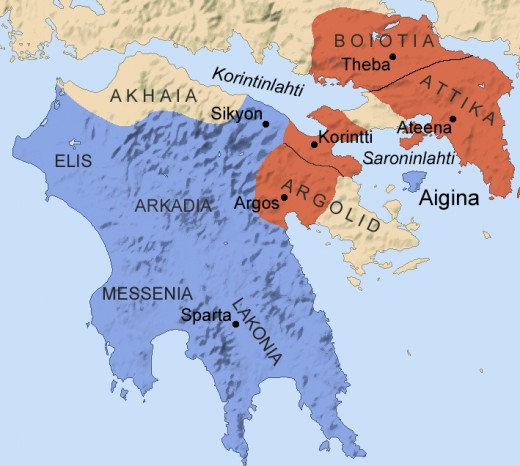
Corinthian War
As Sparta’s political behavior was quite an imperialistic and militaristic, some of Sparta’s former allies during the Peloponnesian war turned aganinst her and joined Athens instead. These states were Thebes, Corinth, and Argos. The Corinthian War lasted from 395 B.C until 387 B.C. The war were fought on two primary fronts, on land near Corinth and Thebes and at the Aegean Sea. At the begining of the war the Spartans gained advantage and won major battles, however they could not capitalise on these advantages adn the war arrive to a stalemate. At sea the Spartan navy was quickly defeated by the Persian navy, which backed the Athens-Corinth-Thebes-Argos coalition (which became the Second Athenian League). This shatted the dreams of Sparta to become a Naval power as well. As a result Athens Recaptured several islands formerly being part of the Athenian Empire. Persia, alarmed at Athenian successes started to back Sparta instead. This defection forced the allies to seek peace. The Peace of Antalcidas was signed in 387 B.C., ending the Corintian War. The treaty declared that Persia would control all of Ionia, all other Greek cities would be independent. Sparta was to be the guardian of the peace. The treaty ensured Persia’s powers and rights to interfere into the politics of the region, and to ensure Spartan hegemony in the region.
Macedonia After Philip II
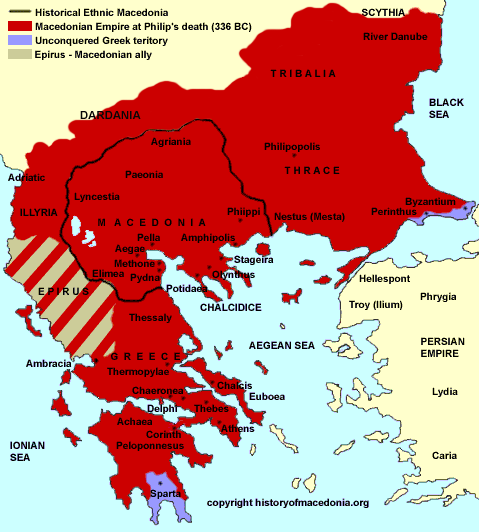
Under Macedonian Rule
In 338 B.C. the Macedonian army of King Philip II defetead a number of Greek city states in the Battle of Chaeronea, and the conquests of his famous son Alexander the Great put an end to both Independent Athens and also the rivalring Greek city states of the region. Although Athens no longer was an independent city, it remained rich and a bustling city. After about 200 years of Macedonian rule Athens, as well as all of the wider region came under the rule of another great power, The Roman Empire.
Roman Athens
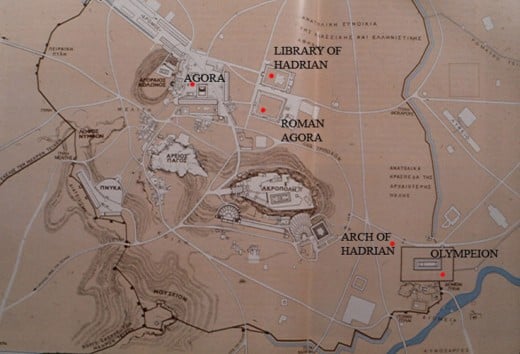
Under Roman Rule
Under the Roman Empire’s rule most of the athenian houses and fortifications were demolished between 88 and 85 B.C by Roman general Sulla, however many of the monument and civic buildings were not. Since Athens’ schools were in very high regard all over Europe and the region, Rome granted Athens the status of a free city. Emperor Hadrian built many buildings such as a library, a gymnasium, an aqueduct and the Temple of Olympian Zeus. In 267 A.D. Heruli sacked the city, burning all public buildings, plundering parts of the city, and damaging the Agora (marketplace of Athens) and the Acropolis. After this, to the north of the Acropolis, Athens was fortified again, however, the Agora was left outside the newly built wall. During the 500 years rule of the Romans in Athens, the city remainded a center of learning and philosophy, in conjuction with Rome. Athenian learning and philosophy was widely supported be the above mentiond Emperor Hadrian. As the Roman emperor converted to Christianity, the city ceased to be such a center. Emperor Justinian closed schools of philosophy in 529 A.D. This event is usually regarded as the ancient history of Athens.
Byzantine Church
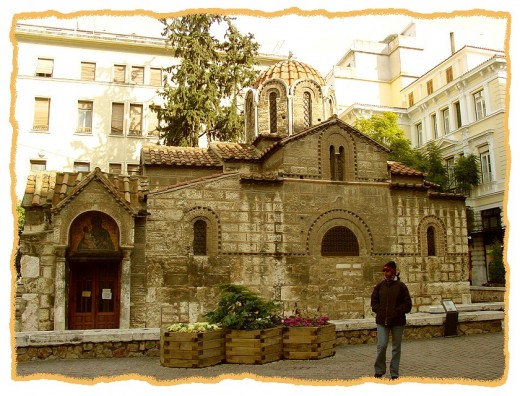
Under Byzantine Rule
During the next roughly 700 years Athens had varying levels of successes and failures. Under the rule of the Byzantine Empire (529-1204) and had grown out of favor. Major ancient Greek temples were converted to christian temples. Early few emperors took the ancient Greek arts to Constantinople (present day Istambul), as they greatly admired ancient Athens. Around 600 Avar and Slavic raids and sackings bleeded out Athens and its population shrank to that of a small town. As by the 7th century most of the Greek peninsula was under Slavic rule, Athens’ fate and future became insecure. By mid 9th century the Byzantine Empire was in full control of the area again, bringing with it the growth and development of Athens. Under the three Komnenos (Greek nobles and dynasty) emperors Alexios, John and Manuel, Attica and the rest of Greece prospered. During this period (11th, and 12th century) the Agora was rebuilt and started to be in use again. Athens became an important center of production of soaps and dye. Trade was on the rise, furthering the enrichment of the town. This period saw the vast building projects of churches, so much so, that the 11the and 12th century represented all the major art an architectural development and project in all of the Byzantine Athens. However in 1204, the fourth crusade conquered Athens, and Athens’ new ruler became the Latin Empire.
Under Latin Rule
After the fall of the Byzantine empire, Athens’ next foreign ruler was the Latin empire, which ruled the town from 1204 to 1458. Although Thebes became the capital city of the duchy, Athens still remained the center of power and defense. In 1311, an army of Franks from Romania (called Catalan Company) attacked and invaded Athens. In 1379, The Catalan Company lost Thebes, and Athens became the official Capital city again. The Catalan company remained in Athens until1388. An Italian aristocrat from Florence, Rainerio I Acciaioli named himself the duke of Athens after the fall of the Catalan Company. Acciaioli’s descendants ruled the city for the next 70 years, when the Ottoman Empire invaded Athens. This was interrupted for a short 7 year period, when between 1395 and 1402 Ventians ruled Athens.
Under latin rule the Acropolis was fortified in this period. The Parthenon served as a Christian church, and was renamed Catholic Church of Saint Mary of Athens.
Propylaea
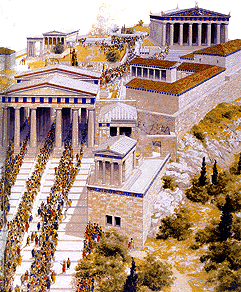
Under Ottoman Rule
In 1458, Athens fell and came under the rule of the Ottoman Empire. The ottomans stayed in Athens for the next 375 years, until 1833, when the indenpendent Kingdom of Greece was was established, with Athens being its capital. As the sultan (the ruler of Ottoman Empire) of the Ottomans, when he entered the city, was very impressed by the architectural heritage of the city, so he gave an order forbiding the sacking of the city. Under Ottoman rule the Parthenon was turned into the central mosque (mosques are muslim churches) of Athens. Although the Ottomans made great effort to turn Athens into the center and capital of the province, the city’s pupolation declined at a very rapid rate. So much so, that by the 17th century Athens population was that of a normal village of the time. During the century Athens suffered great damages due to the decline of the Ottoman Empire. The ottomans stored gunpowder in the Parthenon and in the Propylaea (the gateway entrance of Acropolis). In 1640 a lightning struck the later exploding the gunpowder and destroying the Propylaea. In 1687 Venetians besieged Athens, so the Ottomans dismantled the temple of Athena Nike to fortify the Parthenon. During the bombardment of Athens by the Venitians, the Parthenon was hit, exploding some of the gun powder, and severly damaging the Parthenon. The occupation of the Acropolis continued for six months, but even the Venetians participated in the sacking of the Parthenon. One of the west pediments of the Parthenon was also removed. In 1688, the Ottomans set Athens on fire. Ancient monuments were destroyed to provide material for a new wall with which the Ottomans surrounded the city in 1778. Between 1801 and 1805 Lord Elgin, the British resident at Athens, removed reliefs from the Parthenon. 50 sculptures were purchased by the french and english and carried away.
Independent Athens
In 1822 a Greek insurgency captured the city, but it fell to the Ottomans again in 1826. Again the ancient monuments suffered badly. However, Athenians, as well as the rest of Greece, continued fighting for independence until 1833, when the last Ottoman troops left Athens Athens became the capital of the newly formed Kingdom of Greece. At the time the once large ancient city had only about 4000 inhabitants (from about 140 000 in 500 B.C.). The reason why Athens was named the capital, dispite is small size, was purely for historical and emotional reasons. Otto I, who was a Bavarian prince, became the first ruler of the new Greek kingdom. He was the king from 1832 to 1862. Under his directions, German architechs planned and built the modern city of Athens. The most prominent buildings and institutions established at the time were the University of Athens (1837), Old Royal Palace (now the Greek Parliament Building) (1843), the National Gardens of Athens (1840), the National Library of Greece (1842), the Greek National Academy (1885), the Zappeion Exhibition Hall (1878), the Old Parliament Building (1858), the New Royal Palace (now the Presidential Palace) (1897) and the Athens Town Hall (1874).
Following World War War I, (where Greece was member of the winners, the Allied (Entente) Powers), Greece was engaged in a war against Ottoman Turkey. This war was called the Grece-Turkish wars and lasted between May 1919 and October 1922 in west Anatolia (Asia Minor; Present day Turkey). The reason for this war was that after World War I, Greece, a winner was granted large portions of land in Anatolia for its contributions to the Allied powers of World War One. The Ottoman Empire was a member of the central powers, which lost the war. The reason why Greece wanted western Anatolia, because about 2.5 million greeks lived in Asia Minor at the time. The Chief military general of the Turks were Mustafa Kemal Atatürk. The result of the Greco-Turkish war was three fold:
- Greece gave up its territorial claims to western Anatolia (this would have doubled the land area of Greece),
- Exchange of population. Over 1 million Greek Orthodox Christians in Turkey were resettled in Attica and the newly-incorporated Greek territories of Macedonia and Thrace in exchange of about 500,000 Muslims from the Greek territories being ressettled in Anatolia. Many new suburbs of Athens were started as refugee settlements,
- The creation of a new country on the remnants of the Ottoman empire, the Republic of Turkey.
Under German occupation during World War II
In 1941, George II, King of Greece, and his government fled Athens to Egypt, to avoid confrontation with the German army marching towards the capital city. Athens was occupied by Germany in on April 27, 1941 and remained in the city until 1944, when the Germans withdrew from almost all of Greece to support their Central European troops agains the advancing Red Army of the Soviet Union. The city experienced terrible privations during the later years of the war. In 1944 there was heavy fighting in the city between Communist forces and the royalists backed by the British.
After World War II
Between 1946 and 1949 Athens was one of the scenes of the Greek Civil war that was fought between the National Army and the Democratic Army of Greece. In essence The later was an army led-, and supported by the communist party of Greece. The National Army was the government’s army and it was backed by Great Brittain and the United States of America.
After the war, Athens saw a rapid development. As a result many new job opportunities were created, resulting in a massive inflow of people mostly from neighboring settlements and areas. As Greece joined the European Union in 1981, foreign investments caught more speed and saw the further development of modern Athens. However social, and environmental unrest also grew. For example Athens’ had a very congested traffic, causing air pollition often exceeding healthy levels, in fact air pollution of the time was the worst in Athens. This posed a new threat to the ancient monuments of Athens, as traffic vibration weakened foundations and air pollution corroded marble. The way the city delt with this issue is that it restricted the use of cars in the center of the city. During the 1990s major infrastructural development projects unfolded in Athens (as well as in all of Greece). Example of these were the construction of two of the three new metro lines (lines red and blue), and the Eleftherios Venizelos International Airport. In 2004 Athens hosted the Summer Olimpics games, which bought with it further infrastructural developments, and a sharp rise in foreign tourists visiting Athens. In 2008, after a 15 year old boy was deadly infured from a policeman gunshot at a demonstration after a group of teenagers started a verbal clash with the guarding police of the demonstration. Immediately riots broke out, and by dawn next day, 24 police officers had been injured, one seriously, 31 shops, 9 banks, and 25 cars had been either seriously damaged, burned, or destroyed within the downtown area.
Recommended Links on Athens
- Reconstruction of Ancient Athens
Reconstruction of ancient Athens. - City of Athens | Ο επίσημος ιστότοπος της πόλης της Αθήνας
Official website of the city of Athens - Athens, Greece Hotels, Tourism, Things to Do, Restaurants - Yahoo! Travel
Athens, Greece vacations: Find the best Athens hotels, attractions, maps, pictures, weather, airport information, travel advice and more on Yahoo! Travel. - Hot Hubs about Greece by Sufidreamer
Listing of the Hot hubs about Greece by Sufidreamer.


